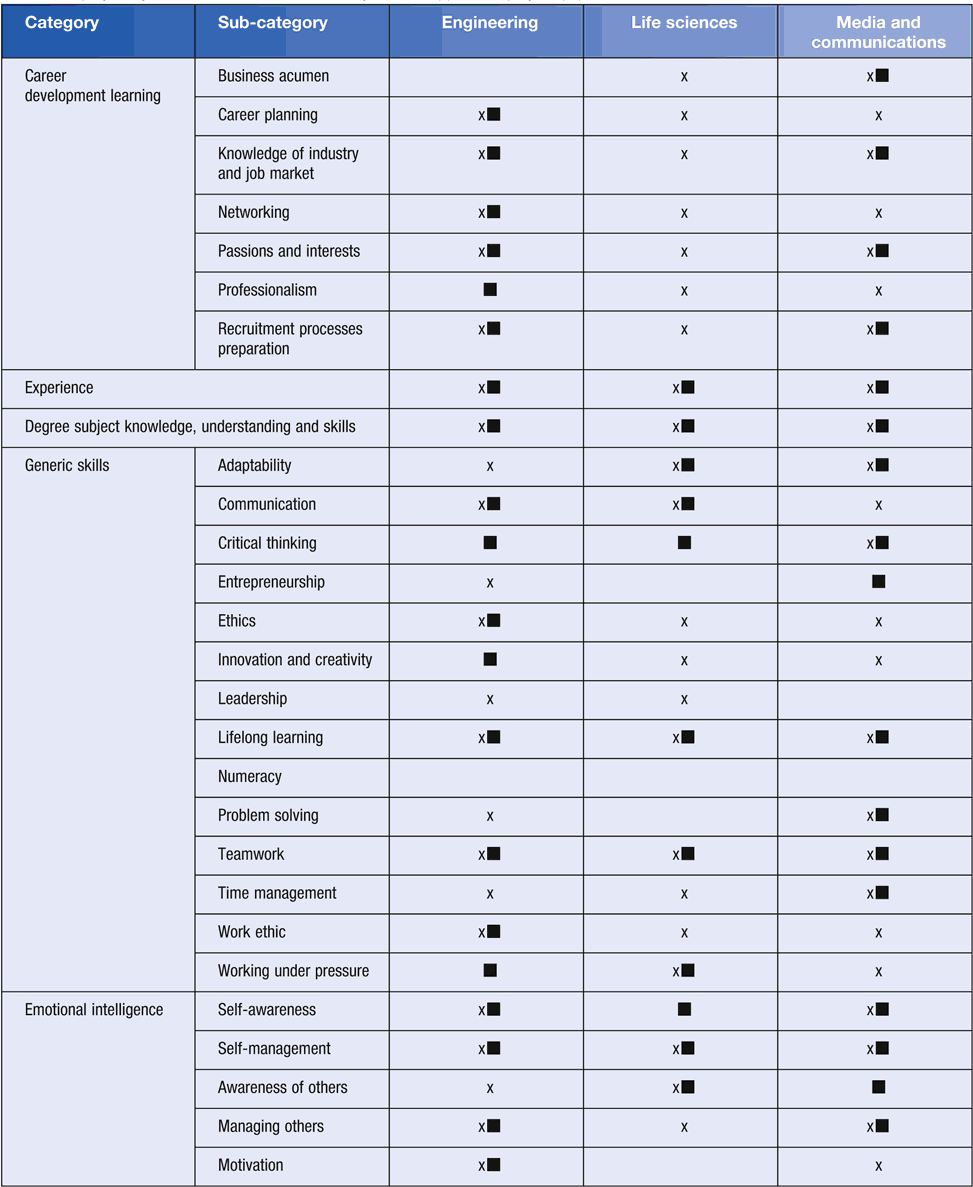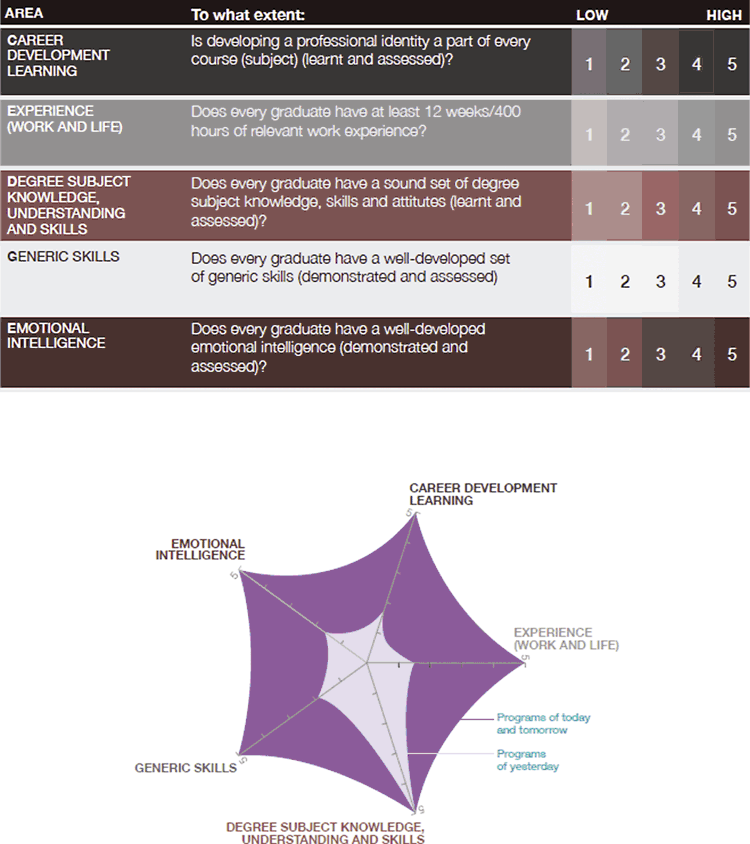What do Life Science employers look for in graduates?
Danilla Grando A E , Catherine Pocknee B , Bronwyn Clarke C and Margaret Jollands DA School of Science, RMIT University, Melbourne, Vic., Australia
B College of Science, Engineering and Health, RMIT University, Melbourne, Vic., Australia
C School of Media and Communications, RMIT University, Melbourne, Vic., Australia
D School of Engineering, RMIT University, Melbourne, Vic., Australia
E Corresponding author. Email: danilla.grando@rmit.edu.au
Microbiology Australia 37(2) 60-64 https://doi.org/10.1071/MA16021
Published: 18 April 2016
As part of an Australian Government Office for Learning and Teaching (OLT) grant to develop graduate employability through partnerships with industry and professional associations1, RMIT University invited industry representatives from Life Science (microbiology focused) professions to a focus group to discuss their views on desirable graduate traits and attitudes. Subsequently current Life Science students at RMIT were also invited to focus groups. Using an expanded framework for graduate employability2, their responses were coded and analysed and compared with responses from similar focus groups from other RMIT programs.
The analysis presented in Table 1 highlights some interesting comparisons between focus groups representing the School of Civil, Environmental and Chemical Engineering, the School of Media and Communications and the School of Applied Sciences. Although there were many similarities in the views expressed across these three schools, there are some notable differences that impact upon the employability of Life Science graduates. Looking at the data for Engineering and Media and Communications, there appears to be a congruence of themes expressed by students and employers. In contrast employers of Life Science graduates were more focused on considering the experience of graduates rather than their career development learning. Given this response it appears desirable to increase the opportunities that students have to engage in work relevant learning opportunities. Instituting a requirement to enable students to gain relevant work experience throughout their undergraduate degree has been recognised by the Office of the Chief Scientist3. Jollands2 also noted that the observed discipline differences ‘may reflect the homogeneity of career paths for Life Science graduates: typically, ‘laboratory technician’ is the first graduate position, with a narrow position description focused on repetitive experimental work.’

|
In the category of emotional intelligence, life science employers spent considerable time in the focus group discussing issues pertaining to self-awareness. Employers had experienced graduates who were overconfident and not willing to take the time to start at the bottom of the career ladder. One employer commented:
they think they can do anything….so think they [can] expect executive management type roles…and they don’t have the skills so they also don’t recognise that they don’t have the skills…
The self-awareness issue is particularly problematic in diagnostic laboratories with one employer commenting’
the other thing I’ve found is problematic is … not having the confidence to ask a question or admit you don’t know how to do something and therefore covering up.
Interestingly both engineering students and life science students did not talk about critical thinking skills, although these were both mentioned by employers as being important. In contrast the students in Media and Communications did discuss this theme. The project leader commented that overall the students from the School of Media Communications gave more sophisticated and reflective views on the nature of employability (Margaret Jollands). It is notable that students from Media and Communications at the participating university have comparatively high employment rates compared to students from other universities studying similar degrees (Bronwyn Clarke). This is likely to be in response to the high number of focused employability projects conducted within this school4 that have resulted from an explicit school directive, that aims to ‘foster the development of graduates as critical and creative thinkers, multi-skilled and collaborative practitioners’4. It would be insightful for all disciplines to do further research in this area to investigate the possible linkages between focused programs and graduate employability outcomes.
Given the current government’s imperative to become an innovation nation (www.innovation.gov.au), it is incumbent upon academics employed in life sciences to investigate and develop strategies that enable their graduates to become critical and creative thinkers. Capstone projects can often promote this type of learning, however, is the learning environment sufficiently scaffolded to ensure learning progresses throughout the capstone project? In many instances projects undertaken by students may have little relevant formative assessment specifically targeted to students’ development of critical and creative thinking. One strategy for addressing this aspect of student learning in capstone projects is to adopt a three phases approach to ensure students receive appropriate and scaffolded feedback on their critical and creative thinking development. Preliminary analysis of a model described by MacKinnon5 shows that scaffolding the learning in Capstone projects using a 3 phase model helps to explicitly develop judgement and critical thinking in complex contexts. The first phase should involve the supervisor exploring synchronously with the student the scope of the project to introduce and establish a culture of critical and creative thinking. In the second phase (mid-way) of the project the supervisor should provide examples of how critical reflection promotes a synthesis of current knowledge and informs the creative development of new ideas. Finally the student must receive constructive and targeted feedback about their critical and creative thinking development in the penultimate version of their final submission before summative assessment. Providing students with the opportunity to give a three minute oral ‘thesis’ (or similar activity) can help students to critically reflect on and articulate their achievements which in turn prepares them to perform orally in future interviews. When this approach was used with students there was a dramatic increase in grades (n = 3, all students scored >95% on summative assessment, D. Grando).
As part of the OLT funded project we interviewed life science employers who were employing graduates to perform microbiology jobs such as laboratory assistants, food quality assurance scientists, medical scientists and regulatory officers. However, there are many other types of jobs suitable for graduates majoring in microbiology6. The Chief Scientist in his 2014 report7 on the future of STEM education states ‘International research indicates that 75% of the fastest growing occupations now require STEM (Science, Technology, Engineering and Mathematics) skills and knowledge’. It may be difficult for us to envisage the jobs of the future but designing programs that result in enhanced employability for graduates can also promote entrepreneurship. When the successful employment outcomes in the School of Media and Communications at RMIT University are considered it is found that as well as high employability rates, there are a high number of students who establish their own companies through the embedded projects in the curriculum and then have the confidence to grow these quickly as graduates (Bronwyn Clarke).
It is important that every Life Science program ensures that their students are able to articulate their professional identity as a science graduate. Students often feel that they are being trained for research positions. A student commented:
It definitely feels like they were just setting us up for research though, it’s like the job options that they … teach you about it’s all just research, there’s no … sales or teaching or like anything focused otherwise … If research isn’t your cup of tea there are other things but they never told us anything, they assumed we’re all here for research and that’s not the case I don’t think.
Industry and students are both challenging our current curriculum/program design. Capstone projects focusing on research may not be enough preparation for the diverse employment opportunities on offer.
In order for program leaders to determine the degree to which their program enhances graduate employability, we have developed a quiz to help assess a program’s approach to developing employability in students (Figure 1). Program leaders should periodically check a sample group of graduating students’ opening letters and CV. It may come as quite a shock to see the gap between employer expectations and student preparation for employment.
In conclusion, both academics and people employed in industry all share a desire to improve student employability. Many of the readers of this issue will have had a rewarding and fulfilling career and would want to help students achieve the same. There is much that academia can do to help students prepare for a working life; however, we need industry to offer work placement to students so that students can graduate with relevant work experience. The OLT grant has given RMIT academics an opportunity to spend time with employers and deepen the relationship between industry and academia. It is important that such discussions continue so that academia and industry are able to help students graduate with realistic expectations, a practiced eye for science’s possibilities and the confidence to step into the world of graduate careers.
References
[1] Jollands, M. et al. (2015) Developing graduate employability through partnerships with industry and professional associations. Strawberry Hills: Office for Learning and Teaching.[2] Jollands, M. (2015) A framework for graduate employability adapted for discipline differences. In Proceedings of the Higher Education Research and Development Society of Australia Conference (HERSA, 2015), Melbourne, 6–9 July.
[3] Prinsley, R. and Baranyai, K. (2015) Stem-trained and job-ready. Office of the Chief Scientist, Occasional Paper Series 12, 1–4.
[4] Arujo, N. et al. (2015) Student engagement for employability: a Belonging Project case study. In Proceedings of the Higher Education Research and Development Society of Australia Conference (HERSA, 2015), Melbourne, 6–9 July.
[5] MacKinnon, P. (2015) Engineering communication. In Short stories: innovative approaches to developing employability in our students (Eds M. Jollands and C. Pocknee). Strawberry Hills: Office for Learning and Teaching.
[6] Rodrigues, S. et al. (2007) The usefulness of a science degree: The ‘lost voices’ of science trained professionals. Int. J. Sci. Educ. 29, 1411–1433.
| The usefulness of a science degree: The ‘lost voices’ of science trained professionals.Crossref | GoogleScholarGoogle Scholar |
[7] Office of the Chief Scientist (2014) Science, Technology, Engineering and Mathematics: Australia’s Future. Australian Government, Canberra.
Biographies
Danilla Grando is an Associate Professor in the School of Applied Sciences. Her teaching interests are online education and program delivery to enhance employability. Her research interests are diagnostic microbiology.
Catherine Pocknee is currently a senior Academic Development Advisor at RMIT and has a strong educational research background. In 2007 she was a leader of the OLT grant; The Work Integrated Learning (WIL) Report: A national scoping study, and in 2014 she was senior project officer for the OLT grant: Developing graduate employability through partnerships with industry and professional associations at RMIT University.
Bronwyn Clarke is the Director of Programs for the School of Media and Communications. Her teaching practice and research interests focus on Belonging and Student Engagement for graduate employability within the Creative Industries.
Margaret Jollands is an Associate Professor in the School of Engineering. She is also Director of the SHEER (Science, Health and Engineering Educational Research) Centre at RMIT University.



